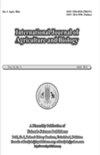饲粮中添加食物垃圾和黑虻幼虫可提高肉仔鸡生长性能、营养物质消化率和肠道微生物群
Q2 Agricultural and Biological Sciences
引用次数: 1
摘要
本研究旨在评估用替代成分替代传统成分对肉鸡生长性能、胴体品质、营养物质消化率和肠道微生物的影响。120只Cobb500肉鸡被随机分配到四个日粮中。玉米、豆粕和鱼粉分别以0、10、30和50%的大米废料、肉和骨废料以及黑蝇幼虫(BSFL)代替,形成四个处理。饲喂替代日粮的肉鸡增重、饲料转化率以及粗蛋白和脂肪的消化率均有所提高。饲料摄入量不受处理的影响,这表明替代饮食被鸡很好地接受。饲喂替代日粮的肉鸡盲肠中大肠杆菌减少,肠道中乳酸杆菌增加。替代日粮中的纤维和几丁质含量可能会改变肠道细菌发酵,从而提高营养物质的消化率。然而,饲喂替代日粮的肉鸡腹部脂肪百分比增加。总之,在日粮中,可以用高达50%的大米垃圾、肉和骨垃圾以及BSFL代替传统成分,对生长性能、营养物质消化率和肠道微生物种群都有很好的影响。©2021 Friends Science出版社本文章由计算机程序翻译,如有差异,请以英文原文为准。
Dietary Replacement with Food Waste and Black Soldier Fly Larvae Supplementation Improved Growth Performance, Nutrient Digestibility and Intestinal Microbial Population in Broilers
This study was aimed to evaluate the effect of conventional ingredients replacement with alternative ingredients on growth performance, carcass quality, nutrient digestibility and intestinal microbial of broilers. One hundred twenty Cobb500 broiler chicks were randomly assigned to four diets. Corn, soybean meal and fish meal were replaced with rice waste, meat and bone waste and black soldier fly larvae (BSFL) at 0, 10, 30 and 50% to form four treatments. Body weight gain, feed conversion ratio and digestibility of crude protein and fat were improved in broilers fed the replacement diets. Feed intake was not affected by the treatments suggesting that the replacement diets were well accepted by the chicken. Escherichia coli was decreased in the cecum and Lactobacillus were increased in the intestines of broilers fed the replacement diets. The fiber and chitin contents in the replacement diets may alter intestinal bacterial fermentation leading to improved nutrient digestibility. However, abdominal fat percentage increased in broilers fed the replacement diets. In conclusion, conventional ingredients can be replaced with up to 50% rice waste, meat and bone waste and BSFL in the diets with promising effect on growth performance, nutrient digestibility and intestinal microbial populations. © 2021 Friends Science Publishers
求助全文
通过发布文献求助,成功后即可免费获取论文全文。
去求助
来源期刊

International Journal of Agriculture and Biology
AGRICULTURE, MULTIDISCIPLINARY-
CiteScore
1.70
自引率
0.00%
发文量
40
审稿时长
5 months
期刊介绍:
Information not localized
 求助内容:
求助内容: 应助结果提醒方式:
应助结果提醒方式:


